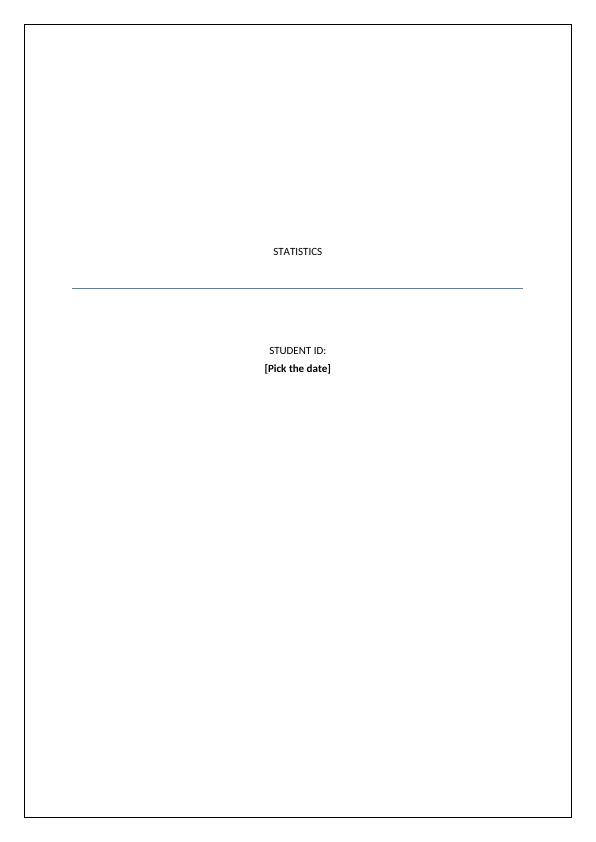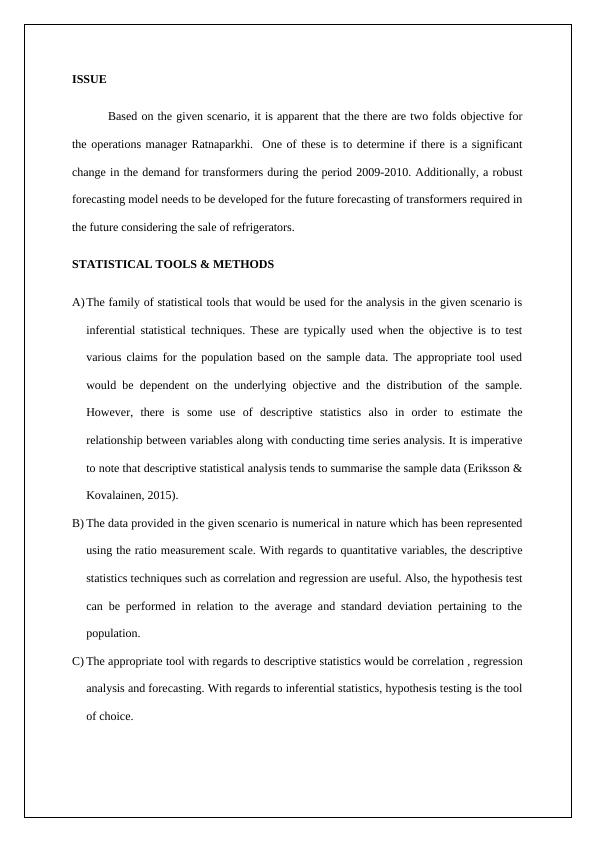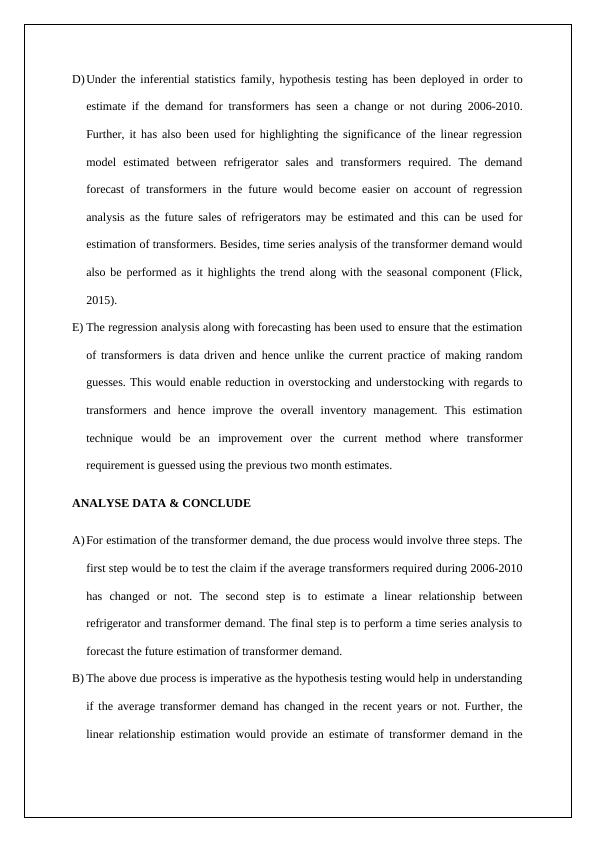Statistical Analysis for Transformer Demand Forecasting
Added on 2023-04-23
8 Pages1332 Words175 Views
STATISTICS
STUDENT ID:
[Pick the date]
STUDENT ID:
[Pick the date]

ISSUE
Based on the given scenario, it is apparent that the there are two folds objective for
the operations manager Ratnaparkhi. One of these is to determine if there is a significant
change in the demand for transformers during the period 2009-2010. Additionally, a robust
forecasting model needs to be developed for the future forecasting of transformers required in
the future considering the sale of refrigerators.
STATISTICAL TOOLS & METHODS
A) The family of statistical tools that would be used for the analysis in the given scenario is
inferential statistical techniques. These are typically used when the objective is to test
various claims for the population based on the sample data. The appropriate tool used
would be dependent on the underlying objective and the distribution of the sample.
However, there is some use of descriptive statistics also in order to estimate the
relationship between variables along with conducting time series analysis. It is imperative
to note that descriptive statistical analysis tends to summarise the sample data (Eriksson &
Kovalainen, 2015).
B) The data provided in the given scenario is numerical in nature which has been represented
using the ratio measurement scale. With regards to quantitative variables, the descriptive
statistics techniques such as correlation and regression are useful. Also, the hypothesis test
can be performed in relation to the average and standard deviation pertaining to the
population.
C) The appropriate tool with regards to descriptive statistics would be correlation , regression
analysis and forecasting. With regards to inferential statistics, hypothesis testing is the tool
of choice.
Based on the given scenario, it is apparent that the there are two folds objective for
the operations manager Ratnaparkhi. One of these is to determine if there is a significant
change in the demand for transformers during the period 2009-2010. Additionally, a robust
forecasting model needs to be developed for the future forecasting of transformers required in
the future considering the sale of refrigerators.
STATISTICAL TOOLS & METHODS
A) The family of statistical tools that would be used for the analysis in the given scenario is
inferential statistical techniques. These are typically used when the objective is to test
various claims for the population based on the sample data. The appropriate tool used
would be dependent on the underlying objective and the distribution of the sample.
However, there is some use of descriptive statistics also in order to estimate the
relationship between variables along with conducting time series analysis. It is imperative
to note that descriptive statistical analysis tends to summarise the sample data (Eriksson &
Kovalainen, 2015).
B) The data provided in the given scenario is numerical in nature which has been represented
using the ratio measurement scale. With regards to quantitative variables, the descriptive
statistics techniques such as correlation and regression are useful. Also, the hypothesis test
can be performed in relation to the average and standard deviation pertaining to the
population.
C) The appropriate tool with regards to descriptive statistics would be correlation , regression
analysis and forecasting. With regards to inferential statistics, hypothesis testing is the tool
of choice.

D) Under the inferential statistics family, hypothesis testing has been deployed in order to
estimate if the demand for transformers has seen a change or not during 2006-2010.
Further, it has also been used for highlighting the significance of the linear regression
model estimated between refrigerator sales and transformers required. The demand
forecast of transformers in the future would become easier on account of regression
analysis as the future sales of refrigerators may be estimated and this can be used for
estimation of transformers. Besides, time series analysis of the transformer demand would
also be performed as it highlights the trend along with the seasonal component (Flick,
2015).
E) The regression analysis along with forecasting has been used to ensure that the estimation
of transformers is data driven and hence unlike the current practice of making random
guesses. This would enable reduction in overstocking and understocking with regards to
transformers and hence improve the overall inventory management. This estimation
technique would be an improvement over the current method where transformer
requirement is guessed using the previous two month estimates.
ANALYSE DATA & CONCLUDE
A) For estimation of the transformer demand, the due process would involve three steps. The
first step would be to test the claim if the average transformers required during 2006-2010
has changed or not. The second step is to estimate a linear relationship between
refrigerator and transformer demand. The final step is to perform a time series analysis to
forecast the future estimation of transformer demand.
B) The above due process is imperative as the hypothesis testing would help in understanding
if the average transformer demand has changed in the recent years or not. Further, the
linear relationship estimation would provide an estimate of transformer demand in the
estimate if the demand for transformers has seen a change or not during 2006-2010.
Further, it has also been used for highlighting the significance of the linear regression
model estimated between refrigerator sales and transformers required. The demand
forecast of transformers in the future would become easier on account of regression
analysis as the future sales of refrigerators may be estimated and this can be used for
estimation of transformers. Besides, time series analysis of the transformer demand would
also be performed as it highlights the trend along with the seasonal component (Flick,
2015).
E) The regression analysis along with forecasting has been used to ensure that the estimation
of transformers is data driven and hence unlike the current practice of making random
guesses. This would enable reduction in overstocking and understocking with regards to
transformers and hence improve the overall inventory management. This estimation
technique would be an improvement over the current method where transformer
requirement is guessed using the previous two month estimates.
ANALYSE DATA & CONCLUDE
A) For estimation of the transformer demand, the due process would involve three steps. The
first step would be to test the claim if the average transformers required during 2006-2010
has changed or not. The second step is to estimate a linear relationship between
refrigerator and transformer demand. The final step is to perform a time series analysis to
forecast the future estimation of transformer demand.
B) The above due process is imperative as the hypothesis testing would help in understanding
if the average transformer demand has changed in the recent years or not. Further, the
linear relationship estimation would provide an estimate of transformer demand in the

End of preview
Want to access all the pages? Upload your documents or become a member.
Related Documents
Statistical Analysis of Internet Speedlg...
|18
|1648
|21
FIN10002 Report on Financial Statisticslg...
|16
|1992
|32
Quantitative Analysis for Operational Improvementslg...
|5
|889
|77
Business Research Methodology Analysis 2022lg...
|4
|775
|38
Critique of a Correlational Studylg...
|5
|997
|384
Simple Linear Regression Tasklg...
|16
|592
|18
